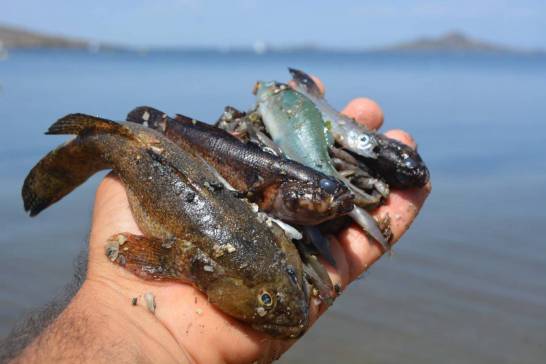In the fall of 2019 and the summer of 2021, we witnessed tons of dead fish washing up on shores. Mar Menor due to lack of oxygen in the water. To avoid events like this, it is vitally important to control the quality of water poured into the pondwhich can be done by measuring water quality indicators such as dissolved oxygen.
Researchers at the Polytechnic University of Madrid created an artificial neural network model to predict the dissolved oxygen in the water discharged into the Mar Menor at the mouth of the river. Rambla del Albujon.
The developed tool, which has shown very good results, allows predictions to be made through a training and learning process that mimics the behavior of neurons.
Uncontrolled proliferation of algae and plants
O eutrophication It is a set of adverse symptoms generated by the increase in the supply of nutrients to the water, which gives rise to the uncontrolled proliferation of plants and algae. This overproduction causes loss of diversity, habitat destruction and mortality of several species due to lack of oxygen. A relevant case of eutrophication is that of the Mar Menor, a coastal saltwater lagoon of great natural importance.
At surrounding areas del Mar Menor are especially rich in different habitats and landscapes, which add interest to this peculiar area. In its surroundings, up to ten figures of environmental protection, of geological and ecosystemic interest converge.
For example, space is integrated within the Nature Network 2000. It has an Area of Special Interest for Birds and is also a Wetland of International Importance. It is, therefore, an area of vital importance from an ecological point of view, which is why it is essential to protect the ecosystems that comprise it.
Location of the study area (Google Earth)
In addition to this natural importance, the area stands out for its intense economic activity, with sectors such as mining, fishing, salt extraction and tourism.
Thanks to Tajo-Segura transfer, a very powerful intensive agriculture was developed in the neighboring area known as Campo de Cartagena. This intense agricultural activity worsens the quality of the water discharged into the coastal lagoon of the Mar Menor through the boulevard Albujón, since the high supply of nutrients causes eutrophication episodes, with a consequent decrease in dissolved oxygen. This parameter has often been used to assess the quality of surface waters and, therefore, the health of aquatic ecosystems.
A model that mimics neurons
The research team relied on data from physicochemical parameterssuch as temperature, pH, nitrates, chlorides, sulfates, electrical conductivity and dissolved oxygen, of the water on Rambla del Albujón in the period from 2014 to 2021. The information was provided by the Ministry of Water, Agriculture, Livestock, Fisheries and Environment of the Region of Murcia and the Segura River Hydrographic Confederation.
The model we developed has shown very good results in forecasts, so it can be an economic and effective tool to manage the quality of water discharged in areas of special sensitivity.
After statistically selecting the most influential on the dissolved oxygen concentration of the water (pH, nitrates and temperature), developed a tool − a backpropagation neural network model (RPROP)− which makes it possible to predict the dissolved oxygen in the water discharged into the Mar Menor through the Albujón avenue.
as pointed out Eva Maria Garcia del Toroco-author of the study: “The model we developed showed very good results in predictions, so it can be an economical and effective tool to manage the quality of water discharged in areas of special sensitivity, such as the coastal lagoon of the Mar Menor in Murcia.
Reference:
Garcia del Toro et al. “Use of Artificial Neural Networks as a Predictive Tool of Dissolved Oxygen Present in Surface Waters Discharged in the Coastal Lagoon of the Mar Menor (Murcia, Spain)”. International Journal of Environmental Research and Public Health.

